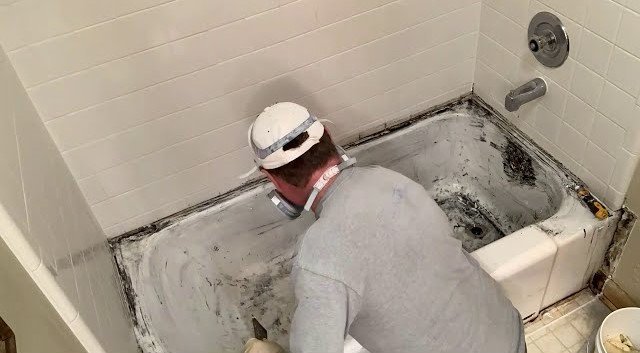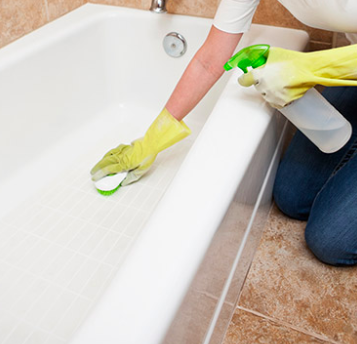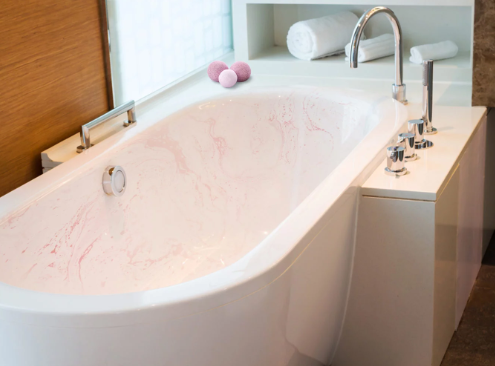A beautiful and well-maintained bathroom is an essential aspect of any home. Many homeowners opt for Bath Fitter services to enhance the aesthetics and functionality of their bathrooms.
Bath Fitter offers a convenient and cost-effective solution for bathroom remodeling.
However, one recurring issue that some homeowners encounter with Bath Fitter installations is mold growth.
This guide will delve into the topic of Bath Fitter mold issues to help you understand the reasons behind mold growth, explore prevention strategies, and tackle this problem effectively.
What is Bath Fitter and How Does it Work?
Before addressing the mold issues associated with Bath Fitter installations, it’s essential to have a clear understanding of what Bath Fitter is and how it works.
Bath Fitter is a company that specializes in bathroom remodeling.
They use a unique process that involves fitting custom-made acrylic bathtub liners, wall systems, and shower bases over existing fixtures, eliminating the need for a complete bathroom renovation.
The process is quick, efficient, and usually completed within a day or two, minimizing the inconvenience for homeowners.
Read more: How Can You Renovate a Bathroom Cheaply?

Understanding the Causes Bath Fitter Mold Issues
Mold growth in bathrooms is a common problem, and it can also occur in Bath Fitter installations.
Several factors contribute to mold development, and it’s essential to recognize and address these issues to prevent mold growth effectively:
Moisture Accumulation
Bathrooms are naturally humid environments due to showers, baths, and sinks. Without proper ventilation, moisture can accumulate on the walls, floors, and even behind the Bath Fitter components. This excessive moisture creates an ideal breeding ground for mold spores to thrive.
Also read: The Surprising Benefits of Placing a Red Cup Under Your Toilet Seat
Poor Ventilation
Inadequate ventilation can exacerbate moisture-related issues in bathrooms. When bathrooms lack proper ventilation, damp air becomes trapped, increasing the chances of mold growth.
High humidity levels also create an uncomfortable environment and may lead to other problems like peeling paint and warped wood.
Sealing Issues
The proper installation and sealing of Bath Fitter components are crucial to prevent water from seeping behind the liners.
Over time, sealants may degrade, leading to potential leaks and moisture infiltration.
If water seeps behind the Bath Fitter, mold can grow hidden from sight, making it difficult to detect until the problem worsens.
Organic Material
Mold requires organic material to grow and thrive. If there are any organic materials, such as soap scum, dead skin cells, or hair, present on the
Bath Fitter surfaces, mold spores can feed on these materials and accelerate the mold growth process.
Also read: Is Flushing While Sitting on the Toilet Safe?
Pre-existing Mold
In some cases, mold may have already been present in the bathroom before the Bath Fitter installation.
If the mold was not properly removed before the installation, it can continue to grow behind the liners, causing recurrent mold issues.

Read more: Why Does Your Bathroom Smell Like Paint Thinner?
Prevention Strategies to Avoid Mold Growth
Prevention is key when it comes to dealing with mold issues in Bath Fitter installations.
By implementing the following preventive measures, you can significantly reduce the likelihood of mold growth in your bathroom:
Proper Ventilation
Ensure your bathroom is adequately ventilated. Install an exhaust fan if you don’t already have one and use it during and after showers to reduce humidity levels.
Additionally, consider leaving the bathroom door or window open after use to promote air circulation.
Regular Cleaning
Regularly clean and maintain your bath fitter surfaces to prevent the accumulation of organic materials that mold spores feed on.
Use non-abrasive cleaners to avoid damaging the acrylic surfaces. Pay close attention to areas where water might collect, such as corners and edges.
Check for Leaks
Regularly inspect the sealant and caulking around the Bath Fitter components to identify any signs of water leakage.
Address any issues promptly to prevent water from seeping behind the liners. Replace old or damaged caulk to maintain an effective moisture barrier.
Monitor Humidity Levels
Invest in a hygrometer to monitor the humidity levels in your bathroom. Ideally, keep the humidity below 50% to discourage mold growth.
If your bathroom consistently has high humidity, consider using a dehumidifier to control moisture levels effectively.
Address Pre-existing Mold
If you notice any mold in your bathroom before the Bath Fitter installation, it’s crucial to address the issue thoroughly. Mold spores can remain dormant and continue to grow even after the installation.
Hire a professional mold remediation service to ensure proper mold removal before proceeding with the remodeling project.

Read more: Homemade Bathroom Cleaner Using Vinegar, Dawn, Baking Soda ( The DIY Guide)
Dealing with Existing Mold Problems
Despite taking preventive measures, you may still encounter mold issues in your Bath Fitter installation. When this happens, prompt action is necessary to prevent the problem from worsening. Here’s how to deal with existing mold problems:
Identify the Extent of Mold Growth
Before attempting to remove mold, it’s essential to assess the extent of the problem.
If the mold is widespread and covers a large area, or if it’s affecting the structural integrity of your bathroom, it’s best to consult a professional mold remediation service.
They have the expertise and equipment to handle severe mold infestations safely.
DIY Mold Removal
For small and localized mold patches, you can attempt DIY mold removal. Mix a solution of equal parts white vinegar and water and apply it to the affected area.
Let it sit for a few minutes before scrubbing the mold off with a soft brush.
Rinse thoroughly and dry the surface completely. Alternatively, you can use hydrogen peroxide or a commercial mold cleaner specifically designed for bathroom use.
Also read: How to Get Rid of Tiny Air Bubbles in Toilet Bowl
Use Mold-Resistant Products
When replacing caulking or sealant around Bath Fitter components, opt for mold-resistant products.
These products have additives that discourage mold growth and provide long-lasting protection.
Mold-resistant paints for bathroom walls are also available, which can help prevent mold growth on painted surfaces.
Improve Ventilation
If your bathroom suffers from poor ventilation, consider installing a high-quality exhaust fan or a dehumidifier to control humidity levels effectively.
Proper ventilation helps reduce moisture accumulation, making the environment less favorable for mold growth.
Regular Inspection and Maintenance
After dealing with mold issues, schedule regular inspections and maintenance of your bathroom to catch any mold recurrence or other potential problems early on.
Address any issues promptly to prevent mold from taking hold again.
Read more: Why My Bathroom Smells Like Urine After Shower
Seeking Professional Help

If you find yourself overwhelmed by mold issues or unsure about the best course of action, do not hesitate to seek professional help.
A mold remediation specialist can assess the situation, recommend appropriate solutions, and ensure the safe and thorough removal of mold from your bathroom. Additionally, Bath Fitter may provide assistance or warranty coverage for mold-related issues, so contacting their customer support can be beneficial.
Also read: Why My Bathroom Smells Like Urine After Shower
Conclusion
Bath Fitter offers an excellent solution for bathroom remodeling, but like any other bathroom, mold issues can arise if proper precautions are not taken.
Understanding the causes of mold growth, implementing prevention strategies, and promptly addressing existing mold problems are essential steps to keep your Bath Fitter installation mold-free.
By following the practical solutions provided in this article and being proactive in bathroom maintenance, you can enjoy a beautiful, functional, and mold-free bathroom for years to come.
Remember that mold issues are not only unsightly but can also pose health risks, so taking mold prevention seriously is in the best interest of your home and family.
Read more: How to Remove Mold Around Your Bathroom Fan
What are the common causes of mold growth in Bath Fitter installations?
Mold growth in Bath Fitter installations can result from moisture accumulation, poor ventilation, sealing issues, the presence of organic materials, and pre-existing mold. Identifying and addressing these factors through proper ventilation, regular cleaning, and vigilant maintenance are crucial for preventing mold issues.
What is Bath Fitter, and how does it work?
Bath Fitter specializes in bathroom remodeling by fitting custom-made acrylic bathtub liners, wall systems, and shower bases over existing fixtures. The process is quick, efficient, and typically completed within a day or two, providing a convenient and cost-effective solution for homeowners.







